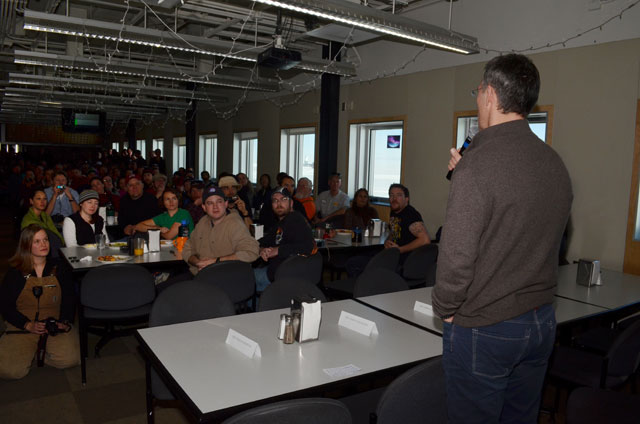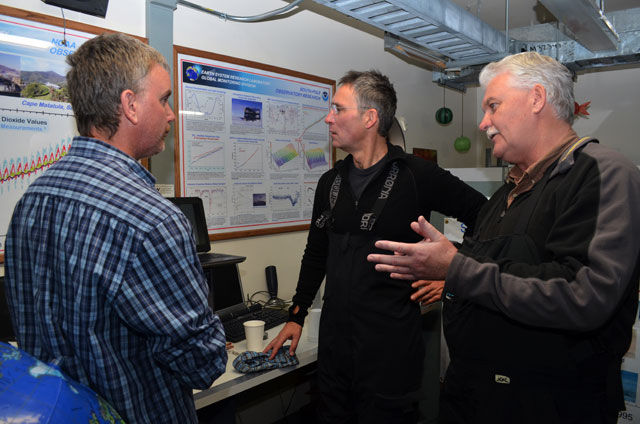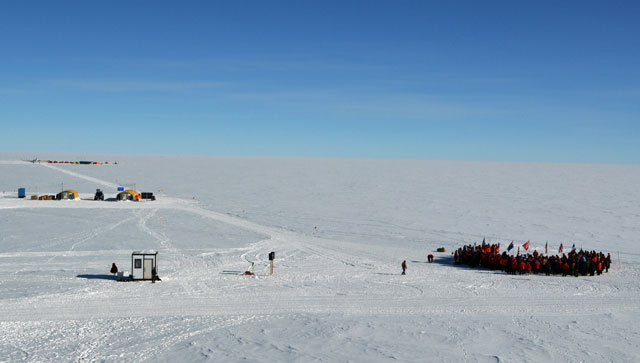Page 2/2 - Posted December 15, 2011
More than 300 people at South Pole for centennial celebrationThe NSF, through its logistics contractor Raytheon Polar Services Co. (RPSC) “In theory, we knew it would work, but we didn't know how well it would do in the cold,” said Ralph Maestas, a videographer with RPSC who started working on the project more than six months ago and helped oversee the broadcasts at the Pole. “We had never laid out that much equipment outside at one time.” It was a neat feat of communications wizardry, as all of the broadcasts took place outside of the station, where the temperature never got above minus 20 degrees Fahrenheit. Also, the station only receives limited connectivity, with about 12 hours of communications over satellites with varying degrees of bandwidth capability. “It’s been a long time planning,” said Bill McAfee, South Pole Station IT manager. “We had to do as much testing as we could, as early as we could.” 
Photo Credit: Peter Rejcek
Norwegian Prime Minister Jens Stoltenberg addresses South Pole Station personnel in the dining facility.
The NSF also provided transportation for the prime minister and his party to the continent from Christchurch, New Zealand. The dignitaries first flew five hours to McMurdo Station, the USAP’s largest research base, aboard a U.S. Air Force C-17. They then boarded a second military aircraft, a ski-equipped LC-130 operated by the New York Air National Guard “Both NSF and the State Department felt it was the appropriate thing to do to support the Norwegians,” said Simon Stephenson, who served as the NSF representative for the centennial event. “It’s a big event for the Norwegians.” The ease of travel is certainly in stark contrast to how Amundsen and Scott reached the Pole 100 years ago. A veteran polar explorer who honed his skills with the Inuit in the Arctic, Amundsen employed sled dogs on this methodical march to the Pole. His rival, the British Capt. Scott, mostly eschewed the use of dogs, as he and his men eventually man-hauled their sleds hundreds of miles across half the frozen continent. Man-hauling was a traditional method employed by the explorers of the Royal Navy in the Arctic. It’s a mode of travel that certainly has the admiration of a team of drivers making their own way across the barren wastes of Antarctica. “Just about all of the new guys are reading about Scott and Amundsen’s adventures,” said Terry Billings, who leads the South Pole Operations Traverse, a convoy of tractors that pull fuel and cargo sleds between McMurdo and Pole, a journey of about 1,000 miles each way. This year, Billings and his team will extend their route by about 500 miles into East Antarctica to retrieve equipment left at a field camp. While enjoying the warmth in the cabs of their tractors, the drivers still endure weeks of isolation, storms and the thrill of the unknown — a link of sorts to the early explorers. “Nobody has traversed there before. There’s no route there. We just have waypoints we’re shooting for,” Billings said shortly before the traverse left the South Pole on Dec. 12, just missing the centennial celebration. “There’s no flagged route; nothing’s groomed. It’s just us and virgin snow.” Of course, some of the trappings of modernity have come to the South Pole. This year, for instance, the NSF established a small retail store and visitor center near the station, using expedition structures called RAC tents that were powered by solar energy. The visitor center contained posters and other decorations related to Antarctic exploration, such as reprints of the New York Times front pages from 1911 and 1912, announcing Amundsen’s achievement and Scott’s death. 
Photo Credit: Scot Jackson
Norwegian Prime Minister Jens Stoltenberg unveils an ice bust of Roald Amundsen during the Dec. 14 centennial ceremony.
Posters of South Pole research were also on display, along with computer stations that played short video clips about U.S.-supported science and logistics in Antarctica. The store offered centennial memorabilia, such as patches and hats. An estimated 93 tourists were present on the anniversary day. Most had skied or flown to the Pole with the support of private tour operators, who had set up a Mount Everest-like base camp not far from the station in cooperation with the NSF. About 300 people are expected to visit the South Pole this year during the brief summer season, with another big pulse of tourists scheduled on Jan. 17 for the Scott anniversary. “One thing that the prime minister’s visit has done for this day is give it a much higher visibility than it might otherwise have [gotten],” said Stephenson, division director of Arctic Sciences Jan-Gunnar Withner A reception and celebratory dinner followed the Dec. 14 ceremony. The prime minister and his contingent left the station the following day aboard another LC-130 — the end of an historic event, but just another chapter in a relationship between two nations. Stoltenberg said he believes Norway and the United States will continue to work together in the Antarctic, as they did during the 2007-08 International Polar Year “There is potential for scientific cooperation in many areas, particularly everything related to polar explorations, but also related to climate change,” Stoltenberg said. “Science is really an area where we need more cooperation. We will achieve more together than if we work alone.” |








